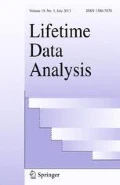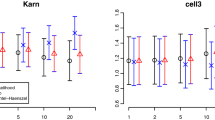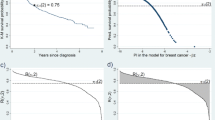Abstract
We study the situation where it is of interest to estimate the effect of an exposure variable \(X\) on a survival time response \(T\) in the presence of confounding by measured variables \(Z\). Quantifying the amount of confounding is complicated by the non-collapsibility or non-linearity of typical effect measures in survival analysis: survival analyses with or without adjustment for \(Z\) typically infer different effect estimands of a different magnitude, even when \(Z\) is not associated with the exposure, and henceforth not a confounder of the association between exposure and survival time. We show that, interestingly, the exposure coefficient indexing the Aalen additive hazards model is not subject to such non-collapsibility, unlike the corresponding coefficient indexing the Cox model, so that simple measures of the amount of confounding bias are obtainable for the Aalen hazards model, but not for the Cox model. We argue that various other desirable properties can be ascribed to the Aalen model as a result of this collapsibility. This work generalizes recent work by Janes et al. (Biostatistics 11:572–582, 2010).



Similar content being viewed by others
References
Aalen OO (1980) A model for non-parametric regression analysis of counting processes. In: Klonecki W, Kozek A, Rosinski J (eds) Lecture notes in statistics-2: mathematical statistics and probability theory. Springer, New York, pp 1–25
Aalen OO (1989) A linear regression model for the analysis of life times. Stat Med 8:907–925
Aalen OO, Borgan Ø, Gjessing H (2008) Event history analysis: a process point of view. Springer, New York
Chen L, Lin DY, Zeng D (2010) Attributable fraction functions for censored event times. Biometrika 97:713–726
Cox DR (1972) Regression models and life-tables. J R Stat Soc Ser B 34:406–424
Greenland S, Robins JM (1986) Identifiability, exchangeability, and epidemiological confounding. Int J Epidemiol 15:413–418
Greenland S, Robins JM, Pearl J (1999) Confounding and collapsibility in causal inference. Stat Sci 14:29–46
Hernán M, Brumback B, Robins JM (2000) Marginal structural models to estimate the causal effect of zidovudine on the survival of HIV-positive men. Epidemiology 11:561–570
Janes H, Dominici F, Zeger S (2010) On quantifying the magnitude of confounding. Biostatistics 11:572–582
Klein J, Moeschberger M (2003) Survival analysis: techniques for censored and truncated data. Springer, New York
Lange T, Hansen JV (2011) Direct and indirect effects in a survival context. Epidemiology 22:575–581
Martinussen T, Scheike TH (2006) Dynamic regression models for survival data. Springer, New York
Martinussen T, Vansteelandt S, Gerster M (2011) Estimation of direct effects for survival data using the Aalen additive hazards model. J R Stat Soc Ser B 73:773–788
Miettinen OS (1972) Components of crude risk ratio. Am J Epidemiol 96:168–172
Miettinen OS, Cook EF (1981) Confounding: essence and detection. Am J Epidemiol 114:593–603
Pearl J (2000) Causality: models, reasoning, and inference. Cambridge University Press, Cambridge
Robins JM (1986) A new approach to causal inference in mortality studies with sustained exposure periods—application to control of the healthy worker survivor effect. Math Model 7:1393–1512
Rothman KJ, Greenland S, Lash TL (2008) Modern epidemiology. Lippincott Williams & Wilkins, Philadelphia
Stare J, Henderson R, Pohar M (2005) An individual measure of relative survival. Appl Statist 54:115–126
Tsiatis AA, Davidian M, Zhang M, Lu X (2000) Covariate adjustment for two-sample treatment comparisons in randomized clinical trials: a principled yet flexible approach. Stat Med 27:4658–4677
van der Vaart AW (1998) Asymptotic statistics. Cambridge University Press, Cambridge
Vansteelandt S, Keiding N (2011) Invited commentary: G-computation—lost in translation? Am J Epidemiol 173:739–742
Acknowledgments
The second author was supported by IAP research network grant nr. P06/03 from the Belgian government (Belgian Science Policy).
Author information
Authors and Affiliations
Corresponding author
Appendix: Large sample properties
Appendix: Large sample properties
1.1 Aalen model
Let us first look at the Aalen model. Let \(Y(t)\) be the \(n\times 3\)-matrix with \(i\)th row equal to \(Y_i(t)(1,X_i,Z_i)\) where \(Y_i(t)\) is the at-risk indicator, and let \(Y^m(t)\) be the \(n\times 2\)-matrix with \(i\)th row equal to \(Y_i(t)(1,X_i)\). We let \(Y^{-}(t)=\{Y^T(t)Y(t)\}^{-1}Y^T(t)\) and similarly with \(\{Y^m\}^{-}(t)\). Also let \(A=(0,1,0)\) and \(A^m=(0,1)\), and let \(N(t)\) denote the vector-counting process \((N_1(t),\ldots ,N_n(t))^T\) with \(N_i(t)=I(U_i\le t,\delta _i)\). Since, with \(B^m(t)=\{B_0^m(t),B_X^m(t)\}\),
using the ordinary least squares inverses, it follows that
where \(M_i\) and \(M_i^m\) denote the counting process martingales with respect to the marginal (conditioning on \(X\)) and the conditional (conditioning on \(X\) and \(Z\)) filtrations. In the latter display, \(R(t)\) is the limit in probability of \(n^{-1}Y^T(t)Y(t)\) and similarly with \(R^m(t)\).
1.2 Cox model
We here sketch the proofs of the asymptotic results for the Cox model. The process \(W_n(t)\) consists of differences like
where
and
with \(n_x=\sum _{i=1}^nI(X_i=x)\) and \(x\) being fixed. We now first show that
where \(\left\{ {\tilde{\epsilon }}_i^{S_j}(t)\right\} _i\) are zero-mean iid terms. This is similar to the proof in (Chen et al. (2010), p. 724–725). Let \(\mathcal{P }_n\) and \(P\) denote the empirical measure and the distribution under the true model, respectively. We write \(\int fdQ\) as \(Qf\), where \(Q\) here denotes a measure. With this notation, the left hand side of (11) can then be written as
where the expectations \(\mathcal{P }_nS_j\{x,{\hat{\theta }}(t);Z\}\) and \(PS_j\{x,{\hat{\theta }}(t);Z\}\) are taken with respect to \(Z\). As in Chen et al. (2010), the third term in (12) can be shown to converge to zero in probability using Lemma 19.24 of van der Vaart (1998) and because of the asymptotic properties of the partial likelihood estimator of the Cox model. The first term in (12) is already of the desired form so we can concentrate on the second term. We have
with \(\dot{S}_j\) denoting the derivative of \(S_j\) with respect to the second (vector)-argument, and where \( \{{\epsilon }_i^{\theta }(t)\}_i \) is the iid decomposition corresponding to \(n^{1/2}\{{\hat{\theta }}(t)-\theta (t)\}\); expressions for these can be found in Martinussen and Scheike (2006) Ch. 7, and their empirical counterparts can be retrieved from the cox.aalen-function in the R-package timereg. Hence, (11) is fulfilled and therefore also
where
are zero-mean iid terms. To handle (10) we let \(n_x^*=n^{-1}\sum _{i=1}^nI(X_i=x)\) and assume that its limit in probability, \(p_x\), say, is larger than zero. Now, rewrite the numerator of the right hand side of (10) as
where
The first term in (13) can be dealt with as we did with the left hand side of (11), and the second term in (13) is already on the desired form. Thus
where
are zero-mean iid terms with \(S_j^x\{x,\theta (t);X,Z\}=S_j\{x,\theta (t);Z\}I(X=x)p_x^{-1}\), and with \(\dot{S}_j^x\{x,\theta (t);X,Z\}\) being its derivative with respect to the second (vector)-argument. Hence, \( W_n(t)=n^{-1/2}\sum _{i=1}^n\epsilon _i^{\Delta }(t)+o_p(1), \) with
being zero-mean iid terms. In (14),
It readily follows that \( \epsilon _i^{\mathcal{T }}(t)=\epsilon _i^{\Delta _1}(t)+\epsilon _i^{\beta _X}, \) where \(\epsilon _i^{\beta _X}\) is the first component of \(\epsilon _i^{\theta }(t)\). Also \( \epsilon _i^{\Delta _{nl}}(t)=\epsilon _i^{\Delta _1}(t). \)
Rights and permissions
About this article
Cite this article
Martinussen, T., Vansteelandt, S. On collapsibility and confounding bias in Cox and Aalen regression models. Lifetime Data Anal 19, 279–296 (2013). https://doi.org/10.1007/s10985-013-9242-z
Received:
Accepted:
Published:
Issue Date:
DOI: https://doi.org/10.1007/s10985-013-9242-z




